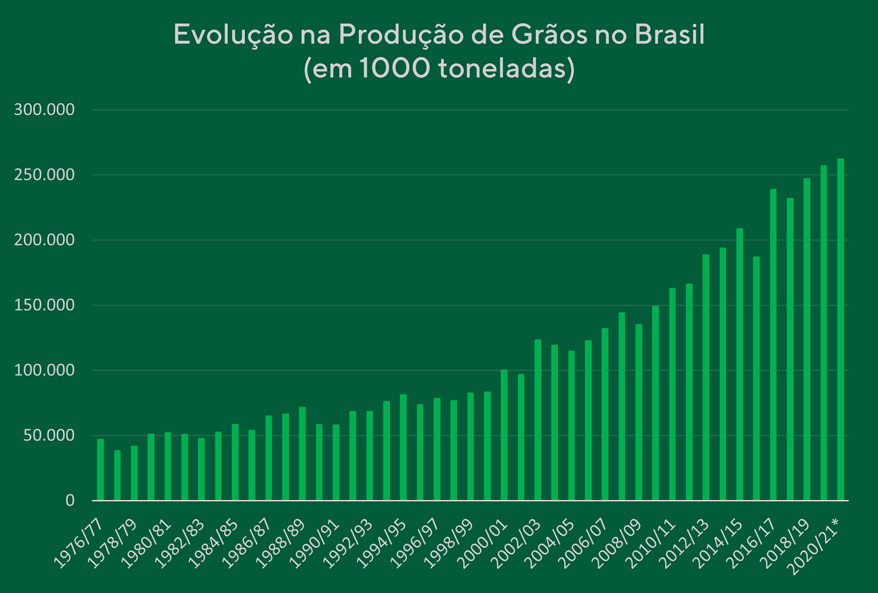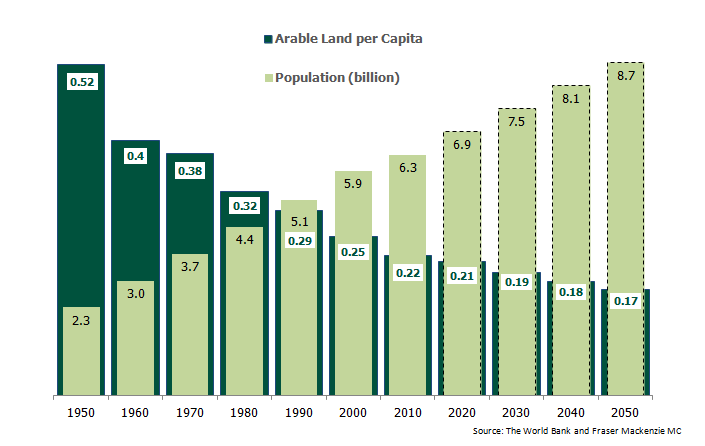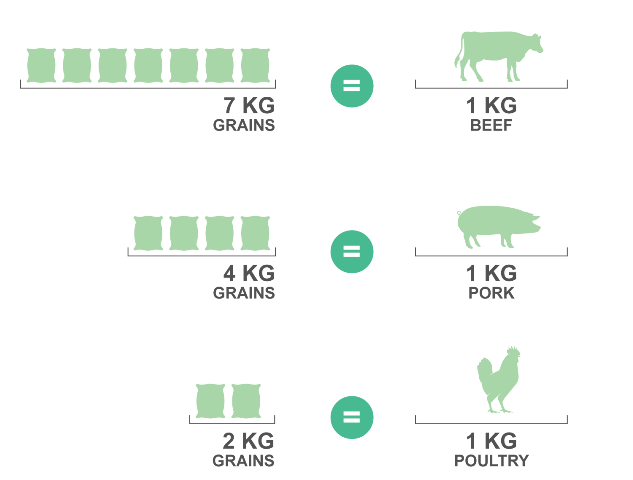The Importance of Agriculture
Confronting a great goal
Agriculture has a great goal: to feed and dress the 9.7 billion people that the UN predicts will inhabit the planet by 2050. This will require a 70% increase in agricultural production, according to the FAO (Food and Agriculture Organization of the United Nations), despite limited availability of farmland and water and increasing environmental pressure.
In addition, we have fewer and fewer people willing to stay in rural areas. For the first time in history, most of the world’s population lives in urban areas. According to the OECD (Organisation for Economic Co-operation and Development), the world’s middle class will more than double, from 2 billion people today to 4.9 billion by 2030.
Population growth associated with increased income especially in developing countries is increasing global consumption of food, clothing and energy. The projected increase in income from developing countries will bring an increase in protein consumption, which is directly related to the consumption of soy and corn. The consumption gap between developed and developing countries is expected to narrow.
We are experiencing an accelerated phase of technological paradigm shifts, and the intensive use of technology will be increasingly indispensable to Agriculture. Some recent scientific events were crucial for agricultural evolution up to the current levels, such as intensification of the breeding process of the late nineteenth century, the “green revolution” in the 1940s, 1950s and 1960s and the advent of biotechnology in the 1980s.
The new revolution in technology-based Agriculture (Digital Agriculture) is based on Sustainability, with a focus on environmental preservation, even becoming part of the solution to reduce greenhouse gas emissions through the use of renewable fuels such as ethanol and biodiesel.
Brazil is (big) part of the solution
EVOLUTION IN GRAIN PRODUCTION IN BRAZIL ( IN 1000 TONS)
Agriculture in Brazil has grown rapidly in recent decades, with increased productivity, as well as the expansion and consolidation of new agricultural frontiers.

Investments in Research and Technology for tropical agriculture were great advantages that made it possible to incorporate the Brazilian Cerrado [savannah] into productive use. According to Embrapa (Empresa Brasileira de Pesquisa Agropecuária), one of the main reasons for the success of agriculture in the Cerrado [Brazilian savannah] region was the development of a successful technological package with emphasis on new varieties adapted to low latitude conditions. There is an abundance of rainfall and the topography is highly favorable to mechanization.
- Stable high temperatures throughout the year (notably in the Cerrado [Brazilian savannah] region)
- Technology developed by research centers
- Plenty of land for cultivation
- Good soil quality
- Flat topography
- Plenty of rain and sunshine
Brazil today occupies a prominent place in world Agribusiness and is among the largest producers and exporters of agricultural products and derivatives, having accounted for 20% of global grain exports, according to the USDA (US Department of Agriculture) (20/21 harvest estimate). The country has all the conditions to occupy even greater space in the international scenario of food and biofuel production, as it has competitive advantages over other countries, in addition to having the largest stock of agricultural land. This competitiveness is due to climatic factors favorable to production and the abundance of agricultural land. Agribusiness represented , in 2020, 27% of Brazilian GDP according to the Ministry of Agriculture, Livestock and Supply (mapa), and agricultural exports have been largely responsible for the country’s trade balance surplus.
| Product | Yield | Export |
| Sugar | 2 | 1 |
| Coffee | 1 | 1 |
| Soybean | 1 | 1 |
| Beef | 2 | 1 |
| Ethanol | 2 | 2 |
| Chicken | 2 | 1 |
| Corn | 3 | 2* |
| Pork | 4 | 4 |
| Cotton | 4 | 2 |
Source: (USDA, 2022 for animal protein and 2021/22 crop year for grains and lint)
The History of Agriculture in Brazil
Indigenous Agriculture
Agriculture was already a practice known by the Brazilian natives, who mainly cultivated certain tubers, in addition to extracting several other plant cultivars of the local flora – either for food or for by-products such as straw or wood – and also native fruits.
Colonial Brazil
Soon after its discovery, natural wealth had not been promising until the introduction of sugarcane production in the Northeast region. The Brazilian economy then became dependent on sugar exports, which did not have much access to markets, but declined in the second half of the 17th century.
Brazilian Empire
Coffee was introduced in the country at the end of the colonial period. However, it was only after it gained independence that production was consolidated in the Southeast region, especially in the state of São Paulo. The immigration of Europeans was accentuated by coffee production in the west of São Paulo, mostly with the arrival of Italians in the country.
Agricultural Diversification
The delay observed in the field no longer met the demand of large urban centers and cities such as São Paulo, Rio de Janeiro and Recife suffered from a shortage of basic genres such as sugar, wheat, beans and others.
During the military regime, Embrapa (Empresa Brasileira de Pesquisa Agropecuária) was created, with the objective of boosting and diversifying the country’s agricultural sources. The organ was responsible for developing new cultivars, adapted to the peculiar conditions of the various regions of Brazil.
Expansion of the agricultural frontiers to the Cerrado [Brazilian savannah] began, a major milestone in Brazilian agricultural history, and thus large producers began to emerge with semi-industrial scale systems of soy, cotton, corn and beans.
In 1960, there were four main agricultural products exported. In the early 1990s, there were nineteen. The advance in these thirty years also included processing: in the 1960s, unprocessed products accounted for 84% of the total exported, a rate that fell to 20% in the early 1990s.
CALMON, Pedro: História do Brasil, São Paulo, 1939, vol.
ARRUDA, José Jobson. História Integrada: da Idade Média ao nascimento do mundo moderno. 2nd. ed. São Paulo: [s.n.], 1996.
BAER, Werner: A Economia Brasileira, Nobel, São Paulo, 2ª ed, 2003
ARRUDA, José Jobson de A.: História Moderna e Contemporânea. Ática, São Paulo, 13ª ed., 1981
Antonio César Ortega e Emanoel Márcio Nunes (2001). Agricultura Familiar: por um projeto alternativo de desenvolvimento local. Viewed on Jul 5, 2010.
Embrapa/Agrobiologia. 49 Anos Dedicados à Pesquisa em Microbiologia do Solo (in Portuguese). Viewed on Dec 13, 2009.
Maria Yedda Linhares (Apr 12, 1999). Pesquisas em história da agricultura brasileira no Rio de Janeiro. Viewed on Dec 22, 2009.

